The 16 Most Impressive Castles in England
There is so much to love about the castles in England; from their formidable structures that dominate so many towns and cities across the country to their incredible history. In fact, English castles are among the most visited tourist attractions in the country.
The medieval castles of England are a big draw to visitors near and far but with so many to choose from (it is said that there are over 4000 castles in England), it is hard to know which are the best castles to visit.
Most of these 4000 castles will have a fascinating history (how can you not when you’ve been around for 1000 years?), but many of them are sadly now in ruins.
This post captures the most impressive castles in England from the point of view of their history and their medieval grandeur. With the help of some fellow travel bloggers, we have included the biggest castles in England, the most beautiful castles in England and the most famous castles in England.
We’ve also included a few accommodation recommendations near each of these English castles in case you want to spend a bit longer in the area on a history fuelled UK staycation.
This post contains affiliate links. If you book somewhere and stay, we may earn a small commission but this is at no extra cost to you.
Some of these English castles are managed by English Heritage. We highly recommend an English Heritage annual membership. Just a couple of visits will cover the cost of the pass.
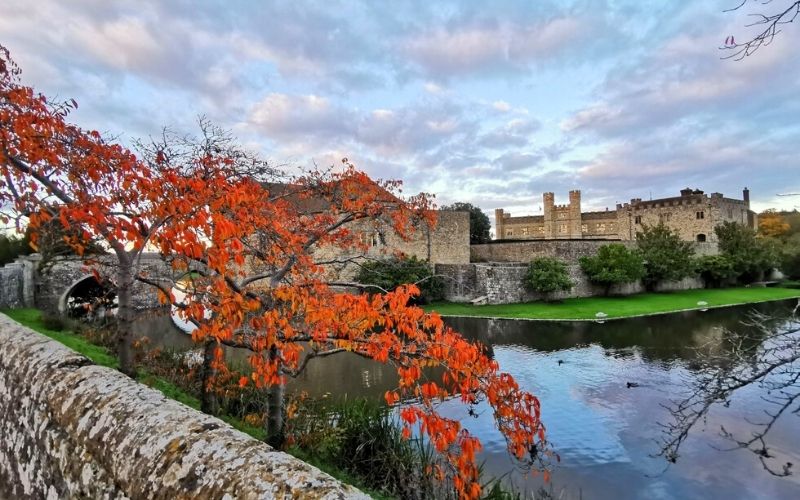
Table of Contents
A brief history of the castles in England
Castles in South East England
Leeds Castle
Windsor Castle
Rochester Castle
Dover Castle
Hever Castle
Bodiam Castle
Framlingham Castle
Castles in London
Tower of London
Castles in South West England
St Michael’s Mount
Castles in Central England
Ludlow Castle
Warwick Castle
Castles in North East England
Alnwick Castle
Bamburgh Castle
Durham Castle
Chillingham Castle
Lindisfarne Castle
Castles in England Map
A brief history of the castles in England
Castles appeared in England rather suddenly following William the Conqueror’s victory at the famous Battle of Hastings in 1066 (the Norman Conquest).
Prior to 1066, there had been Bronze and Iron Age fortifications, but these were mainly in the form of hilltop forts with commanding views of the surrounding countryside and ditches and ramparts forming their defence.
Following their invasion of England, the Normans introduced their French castle building skills starting with wooden and then stone Motte and Bailey castles, often built on the previous hilltop fort locations.
Some of the best surviving examples of Motte and Bailey castles in England today are the Tower of London and Windsor Castle.
The Motte and Bailey design consisted of a mound of earth (Motte) and an enclosed courtyard (Bailey). The design was not infallable, so along came the concentric castle in the 13th century which was essentially a castle within a castle, with two huge defensive walls. Dover Castle is a great example of this design.
During Tudor times, there was more threat of invasion and so King Henry VIII had more castles built as well as refurbishing existing castles. Leeds Castle is one of the castles that he refurbished and it is where his first wife, Catherine of Aragon, lived.
In 1642, the English Civil War broke out and castles were once again used as defensive structures, but then peace resumed and castles began to decline as people favoured more palatial residences.
During the 18th and 19th centuries, castles in England returned to favour again and thankfully many were restored which has meant that we can enjoy them today.
Did you know that Wales has more castles per square mile than any country in Europe? If you’re thinking of visiting Wales, make sure to read our family-friendly North Wales itinerary.

Double outer walls of the Tower of London
Castles in South East England
Leeds Castle
Leeds Castle is one of the most impressive moated castles in England and the best of the Kent castles. It is also said to be the loveliest castle in the world.
There has been a castle on the site since 1119, although this is not the castle that you see today. It has been significantly modified over the centuries, most notably by its most famous owner, King Henry VIII, who completely transformed it for his first wife, Catherine of Aragon.
These days it is one of the most visited historical buildings in England and tops the list of the things to do in Kent. The castle itself is stunning, but you can also enjoy a full day out here because there is so much to see and do at Leeds Castle.
If you’re looking for a day out from London with the kids, it is one of the best castles near London. There is a fantastic play area for kids with an enormous fort as well as a maze, falconry display and other fun activities during the school holidays.
Leeds Castle is currently running an offer whereby you can return as many times as you like for the next 15 months for free when you buy your entry ticket.
If you are driving to Leeds Castle, there is a large on-site car park and parking is included in the price of your ticket.
If you are looking for day trips from London by train, Leeds Castle makes the perfect choice – particularly if you are looking for things to do in Kent at Christmas.
Visiting Kent during the October Half Term? We have a post on where to go pumpkin picking in Kent and Halloween events in Kent. Leeds Castle has loads on at Halloween too and makes for a great Halloween holiday getaway.

Leeds Castle at sunset
Location: Leeds Castle, Broomfield, Maidstone, Kent, ME17 1PL
Entry: Adult – £31.50, Child (4-15) – £21.50, Family – £79.00 (Under 4 – FREE). Pay once – visit all year.
Accommodation: There are numerous options in Leeds Castle itself
Accommodation for families: Knight’s Glamping
Windsor Castle
Submitted by Emma from Travel on a Time Budget
If you’re looking to visit an impressive English castle, then a trip to Windsor Castle, the world’s oldest castle, the largest castle in England and home to the British Royal Family, will fit the bill.
Built by William the Conqueror after the 1066 Norman Conquest, it’s a wonderful place to visit. However, the fact that this is one of the main royal castles in England, means that the Queen is often at home and parts of the imposing building are out of bounds to visitors.
Key things to see in the castle complex are the medieval Windsor Castle Round Tower, one of the earliest parts to be built. Check whether the flag is flying from the top – if it is, the Queen is at home. There’s also the magnificent St. George’s Chapel, constructed initially under the reign of Edward IV, but finished by Henry VIII. You’ll undoubtedly recognise the chapel from recent Royal weddings.
Inside the castle, it’s possible to visit parts of the State Apartments and Semi-State rooms. There are bright and opulent reception rooms and drawing rooms with grand and ornate chandeliers dangling from the ceilings. There’s then St. George’s Hall – bigger and less grand – but no less striking and memorable than other areas of the castle.
A visit to Windsor Castle is an easy day trip from London. There is a train station literally minutes from the entrance and parking nearby. Just don’t forget to pop around the corner to Windsor Great Park before you leave. Here, you’ll find the 3-mile Long Walk. Stroll down this for ten minutes and look back. You won’t be disappointed!
Visiting Windsor with kids? Don’t forget that Legoland Windsor is just around the corner.
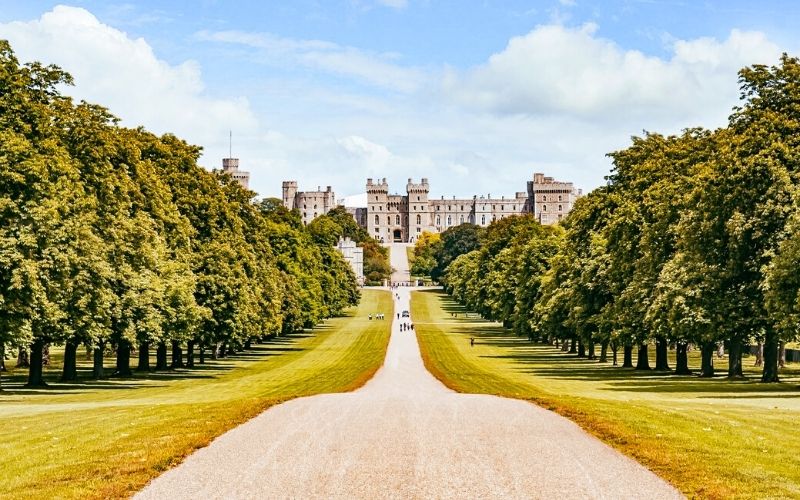
Windsor Castle
Location: Windsor Castle, Windsor, Berkshire, SL4 1NJ
Entry: Adult – £31.00, Child (5-17) – £15.50.
Rochester Castle
Rochester Castle was built in the 1080s to command an important river crossing and is one of the oldest castles in England. Despite most of the castle now standing in ruins, Rochester Castle is the tallest remaining medieval structure in Europe.
Rochester Castle was one of three royal castles in Kent with Canterbury Castle and Dover Castle being the other two. Although it survived three attacks, it was badly damaged in a siege in 1215 by King John. His son, Henry III, repaired the keep and used the castle for royal entertaining in the mid-13th century.
By the latter part of the 16th century the castle was completely redundant and Queen Elizabeth I ordered that the stone from the curtain walls be used to build another fort. There are just small sections of the original outer wall remaining today.
Inside the castle you will be able to visit the chapel, the mural gallery and the battlements. The views from the top are stunning. Note that the castle is currently undergoing maintenance and is therefore closed to the public.
There are several car parks in the town centre but no dedicated castle car park.
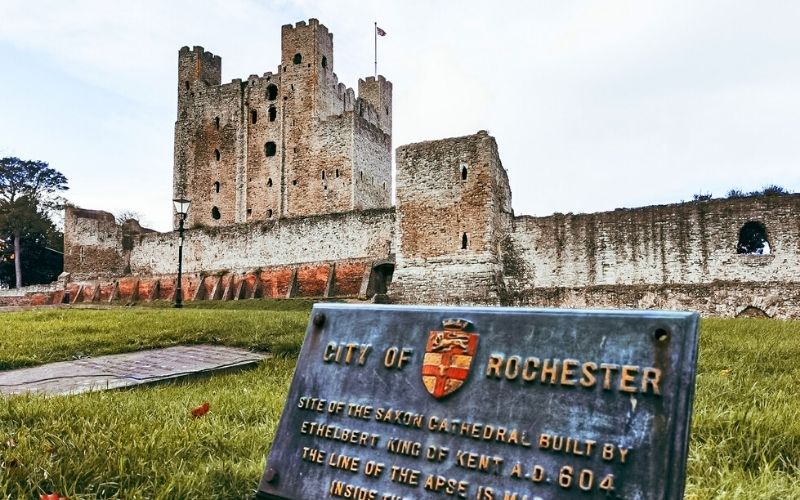
Rochester Castle
Location: Castle Hill, Rochester, Kent, ME1 1SW
Entry: Adult – £7.00, Child (5-17) – £3.50, Family – £17.50
Dover Castle
Submitted by Anisa from Two Traveling Texans
You will be impressed by how much there is to see when you visit Dover Castle! It was established as a hill fort around 800 BC and has played a significant role in English history pretty much ever since.
It is also one of the most impressive concentric castles in England. The Castle Keep, called the Great Tower, was started by Henry II in the 12th century, the Dover Castle tunnels were used for planning during World War II, and there are even some Roman ruins.
There are many things to see at Dover Castle. Start at the lighthouse which dates back to 43 AD and has been named Roman Pharos. It is the oldest structure at the site and the most complete standing Roman building in England. At one time, the lighthouse was used as a bell tower for the Anglo-Saxon church, St. Mary in Castro, next door.
Next, you can go inside the Castle Keep to see what it looked like during the time of Henry II. Then tour the Secret Wartime Tunnels and learn what Operation Dynamo was like behind the scenes. You can walk through tunnels used as the Underground Hospital in World War II. If you have more time, there are also Medieval Tunnels to explore.
Dover Castle is an English Heritage site, so members can visit for free. The normal ticket price for adults is 24 GBP (Reduced to 17 GBP because of Covid restrictions). If possible, allocate a full day to see Dover Castle as it is much larger than you might expect. It is located next to the town of Dover in Kent and there is parking available on site.
If you are looking for more things to do in the area, the beautiful small town of Rye in East Sussex is just along the coast and where you’ll find Camber Castle, another artillery fort of King Henry VIII.

Dover Castle
Location: Dover Castle, Castle Hill, Dover, Kent, CT16 1HU
Entry: Adult – £17.00, Child (5-17) – £10.20, Family – £44.20
Hever Castle
Submitted by Jamie from Travel Addict
Hever Castle is located just south-east of London in Kent, and makes for a great day trip from London to enjoy the countryside and a stunningly beautiful historical castle. There is free parking available at the castle.
Hever Castle has a long history dating back to 1270 and was the childhood home of Anne Boleyn, Henry VIII’s second wife. It later became the home of Henry VIII’s fourth wife, Anne of Cleaves. It has exchanged hands several times over the ensuing years but most recently was renovated by William Waldorf Astor in the early 1900s.
The castle is well known as a tourist attraction for its lengthy history and immaculate grounds. The expansive gardens provide an idyllic paradise to wander through and feature two different mazes to explore, which are lovely on a nice day. There’s also a charming lake with row boats for hire.
The castle hosts a variety of activities throughout the year, but their summer jousting events are brilliant fun for all ages. One of the lawns at the castle is turned into a jousting field complete with horses and lances. It’s a fantastic event to catch if you have the opportunity.

Hever Castle
Location: Hever Castle, Hever Road, Hever, Edenbridge, Kent, TN8 7NG
Entry: Adult – £15.55, Child (5-17) – £9.75, Family – £42.75 (Garden only. Tickets for the castle may be purchased for an additional charge at the castle entrance)
Bodiam Castle
Submitted by Ann from The Road is Life
Located in the heart of the pretty East Sussex countryside is the 14th century Bodiam Castle. It’s surrounded by fields, greenery and a large moat, truly a magical sight.
The castle was built in 1385 by Sir Edward Dalyngrigge who was a former knight of King Edward III. Its original purpose was to protect the area from the French during the Hundred Years’ War.
Over the centuries, the castle sadly fell to ruin due to neglect and to this day, all that’s left intact is the outer wall. Some restorations took place in the 20th century before it was opened up to the public.
Although there is not much left to see inside, tourists are permitted to walk through the interior. The main highlight is climbing one of the towers to see the beautiful countryside views from the top.
Visiting Bodiam Castle makes a fantastic way to escape the bustle of the city and spend a day in the English countryside. This river walk near Bodiam Castle provides beautiful views of the castle . Getting there from London is a 1.5 hour drive and there is plenty of parking available on site.
If you’re planning to travel by train, you’ll need to catch the train to Robertsbridge Station and then take a short taxi from there to Bodiam Castle.

Bodium Castle
Location: Bodiam Castle, Bodiam, Near Robertsbridge, East Sussex, TN32 5UA
Entry: Adult – £10.00, Child (5-17) – £5.00, Family – £27.00 (Car parking is £4.00)
Framlingham Castle
Framlingham Castle in Suffolk is one of the best English Heritage castles in East Anglia. These days, Framlingham is probably more famous for being where Ed Sheeran grew up than for having a castle, but the castle should not be missed. In fact, Ed Sheeran’s song – ‘Castle on the Hill’ is based on Framlingham Castle.
Framlingham Castle was built in the 12th century, originally as a motte and bailey castle and later with a formidable curtain wall. Its claim to fame is that Mary Tudor was pronounced Queen of England in 1553 while she was residing at Framlingham Castle.
It is one of the best places to visit in Suffolk with kids because the castle usually has fun and educational events on during the school holidays. Kids will also love running up and down the steep hills outside the castle.
Inside the castle, you can climb up onto the 10 metre high walls and walk the circumference of the castle. There are stunning views over the surrounding countryside and you’ll be able to get a closer look at the Tudor chimneys; the best preserved of their kind in the country.
There is a small dedicated car park which is free with your entry ticket.
Whilst in Suffolk, you might also like to visit Orford Castle which is only 15 miles away and is another great example of medieval castles in England. There are also plenty of great beaches in Suffolk if you are visiting in the summer months.

Framlingham Castle
Location: Framlingham Castle, Church Street, Framlingham, Suffolk, IP13 9BP.
Entry: Adult – £11.30, Child (5-17) – £6.80, Family – £29.40 and FREE for English Heritage members.
Castles in London
Tower of London
The Tower of London is one of the most famous castles in England, if not the most famous and one of the most important of the William the Conqueror castles. Shortly after his victory at the Battle of Hastings in 1066, William the Conqueror set about building a huge fortress in London.
It has had a very colourful past and has been a secure prison for some of the country’s worst (or deemed to be worst) traitors; Guy Fawkes, Sir Walter Raleigh and Anne Boleyn are among the most famous. It is said that if Hitler had been captured, he would have been sent to the Tower.
Today it is home to the heavily guarded Crown Jewels as well as 6 ravens, the Guardians of the Tower. There is a legend that if all 6 of the ravens leave, the Tower (and the monarchy) will fall. The Yeoman Warders and their families also live within the walls.
A Yeoman Warder (more commonly known as a Beefeater) is a guardian of the Tower of London. They were originally Royal bodyguards and were introduced by Henry VIII to guard the Tower.
These days, the Yeoman Warders need to have served at least 22 years in the armed forces to become a Yeoman. Make sure take a Yeoman Warder’s tour which is included in the price of your entry ticket.
The easiest way to get to the Tower of London is by tube. Tower Hill is the closest tube station. You can also get a Thames Clipper which has a stop at the Tower or many buses pass by the Tower.
If you’re looking for somewhere to eat nearby, check out the Coppa Club Tower Bridge.
If you’re visiting London at Christmas, the Tower of London is home to one of the best ice skating rinks in London.
See our full review of visiting the Tower of London with kids.

Tower of London
Location: Tower of London, London, EC3N 4AB.
Entry: Adult – £25.00, Child (5-17) – £12.50, Family – £37.50.
Castles in South West England
St Michael’s Mount
St Michael’s Mount is an iconic medieval castle occupying a prominent position on an island off the coast of Cornwall, reachable by the man-made causeway at low tide and by boat. When planning your visit, note that the castle closes for the winter and may also close during inclement weather.
It started life as a monastery, built by the same order of Monks who built Mont St Michel in France. In 1193, it was seized by Henry La Pomeray and morphed into more of a defensive castle structure. It witnessed many battles through the centuries including the War of the Roses in 1473 and culminated with the English Civil Wars in the mid 17th century.
Today, St Michael’s Mount is occupied by the St Aubyn family who owned the property from the mid 17th century. They no longer own the property as it was given to the National Trust in 1954 but a unique arrangement gives the St Aubyn family a 999 year lease to occupy it and run the visitor business.
Of particular interest are the sub-tropical terraced gardens and the views of Mount Bay which are just stunning. There is parking (payable) at the St Aubyn Estates car park in Marazion.
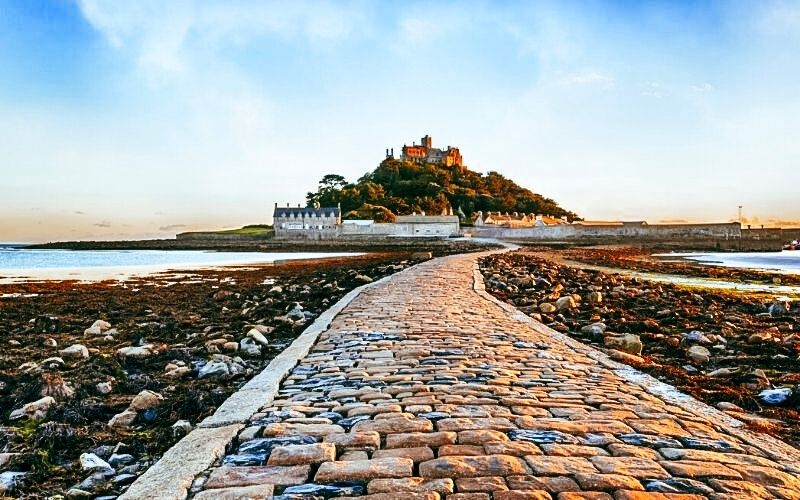
St Michael’s Mount
Location: St Michael’s Mount, Marazion, Cornwall, TR17 0HS.
Entry: Adult – £11.50, Children – £5.50, Family of 4 – £28.50 and FREE for National Trust members.
Castles in Central England
Ludlow Castle
Ludlow Castle is located in Ludlow in Shropshire and enjoys a prominent position overlooking the town of Ludlow which is nestled in the bend of the River Teme.
The contruction of Ludlow Castle was started in 1085 by William FitzOsbern who arrived in England with William the Conqueror in 1066. He was given the title of 1st Earl of Hereford because of the part he played in the Norman invasion of England.
From 1461 and for the next 350 years, the castle was held by the Crown and underwent extensive refurbishment, giving it an Elizabethan stately home appearance.
The castle has been owned by the Earl of Powis since 1811 who has ensured its upkeep. Today, visitors can enjoy visiting the castle and attending one of the many events held throughout the year.
The nearest parking is at Ludlow Castle Street car park (payable) which is a short stroll away.

Ludlow Castle
Location: Castle Square, Ludlow, Shropshire, SY8 1AY.
Entry: Adult – £8.00, Children (5 – 16) – £3.50, Family of 4 – £20.00.
Warwick Castle
Submitted by Stephanie from Explore More Clean Less
Located in central England, Warwick Castle is a huge tourist attraction along the River Avon. Visitors can arrive by train (with a short walk from the train station), car, or a commercial tour.
There are a number of parking options at varying price points as well as a drop-off option for young, elderly, and disabled visitors. Save money by buying tickets online ahead of time and browse the packages with different amenities before arriving.
First built as a wooden fort in 1068 at William the Conqueror’s command, the castle’s ownership has gone through several different families but is now managed by an entertainment company. It is one of the most entertaining castles in England and one of the best castles in the world to visit with kids.
The grounds and buildings have a long history of power struggles and family drama over the centuries but has now become a commercial destination.
While there are historical elements to the tours and signage, the focus is more on family fun and entertainment where visitors can enjoy live jousting, falconry shows, and story-telling performances.
Visitors of all ages can try their hand at archery and explore the Horrible Histories hedge maze, in addition to witnessing the largest siege machine in the world: a reproduction trebuchet that is regularly operated for demonstrations.
There are many places to eat within the castle, making it easy to spend a full day on the grounds!
They also run special events throughout the year such as The Haunted Castle at Halloween or a festive Santa Sleepover.
See here for our guide to the other Merlin attractions at Christmas and Merlin attractions at Halloween.

Warwick Castle
Location: Warwick Castle, Warwick, Warwickshire, CV34 4QU.
Entry: £16.00 per person (aged 3+).
Castles in North East England
Alnwick Castle
Submitted by Heather from Conversant Traveller
Dating back to the 14th century, Alnwick Castle stands proud in the heart of north east England, and, being one of the most impressive castles in the north of England, has long been one of the most popular places to visit on a weekend in Northumberland.
It’s been a stronghold and a home to the Percy family for more than 700 years, starting out life as one of the original motte and bailey castles in England. Today, Alnwick Castle is the second largest inhabited castle in England, lived in by the 12th Duke and Duchess.
Visitors can tour areas like the medieval towers, inner bailey and ornate state rooms, learning about the intriguing history; from dashing earls and executed plotters to Civil War survival and more recent restoration. The castle was also the birthplace of Harry Hotspur, a famous knight with a reputation for rash actions in battle, who was later immortalised by Shakespeare.
Alnwick Castle has been used as a location for many films and TV dramas, most notably Downton Abbey and Harry Potter, and guided tours will spill the beans about areas that were used and who was here.
The extensive grounds surrounding the castle are worth a look too, with vast swathes of daffodils in Spring making for stunning photos. There is plenty of parking at Alnwick Castle, and most visitors make a day of it by including a trip to the adjacent Alnwick Gardens as well, which is a separate attraction.

Alnwick Castle
Location: Alnwick Castle, Alnwick, Northumberland, NE66 1NQ.
Entry: Adult – £8.00, Child (16 and under) – FREE.
Bamburgh Castle
Submitted by Anuradha from Country Hopping Couple
Bamburgh Castle is one of the finest castles in England. Sitting majestically 150 feet above sea level overlooking the heritage coast, a visit to Bamburgh Castle is a must if you are travelling in the North East of England.
The history of Bamburgh Castle dates back more than 1000 years. Around the mid-5th century, a fortified settlement was established and subsequently moved hands from Britons to Anglo-Saxons, finally coming into Anglo-Saxon custody in 547AD. The fort was destroyed by Vikings in 993AD. The Normans arrived in the 11th century and built a new castle on the same site in the 12th century. The property was then passed over to the English Monarch.
In the 19th century, the castle was bought by a wealthy engineer, William Armstrong, who renovated and restored the castle. The castle still belongs to Armstrong family.
If you like history, castles and breathtaking coastal views, you should definitely visit Bamburgh Castle. There are 14 rooms to explore inside the castle including elegant state rooms, a medieval kitchen and a grand King’s Hall, which is truly a Victorian masterpiece. The castle houses as many as 3000 artifacts that include porcelain plates, armour, clocks, furniture and paintings depicting the thousand year history of the castle.
Bamburgh Castle is located on the northeast coast in the village of Bamburgh. There are train and bus services that connect to Bamburgh. All day parking costs £3 that also gives access to beach and village (but not the castle).

Bamburgh Castle
Location: Bamburgh Castle, Bamburgh, Northumberland, NE69 7DF.
Entry: Adult – £11.16, Child – (5-18) £5.46, Under 5 – FREE.
Durham Castle
Submitted by Stuart from Go Eat Do
Durham Castle overlooks the River Wear at the heart of Durham City in north-east England. The Wear loops around on itself at this point, creating a finger-like strip of land. With steep sides and water around most of it, Norman settlers decided this was an ideal location for a fortress. Consequently, they built a motte and bailey castle in the 1070s. The Normal Chapel dates from that period.
It’s still possible to see the artificial hill of the now grassy motte beneath the castle’s hexagonal tower. Together with Durham Cathedral on the other side of Palace Green, the castle was designated as a UNESCO World Heritage Site in 1986. The world heritage site visitor centre at Owengate tells the story of both.
The fortress was long a home to the Prince-Bishops of Durham. The Bishops’ temporal powers included being able to mint money and raise an army. The Bishops’ Suite, within the castle, features a four-poster bed and offers visitors a place to overnight within the castle. Parking spaces are available on Palace Green.
During the biennial Lumiere Durham festival of lights the walls of the castle count among the buildings illuminated by installations. Now occupied by Durham University’s University College, student-led tours are a way of entering and viewing points of interest inside the castle.
There is no dedicated car park at the castle. The closest car park is the Prince Bishops car park just a short stroll away.

Durham Castle
Location: Durham Castle, Durham, County Durham, DH1 3RW.
Entry: Adult – £5.00, Children – £4.00, Under 5 – FREE, Family of 4 – £15.00.
Chillingham Castle
Submitted by Shobha George from Epic England Travel
Built in the 12th century, Chillingham Castle in Northumberland started off as a monastery. Upon seeing the hulking mass of dark stone, one can readily believe is the most haunted castle in England. Located on the border between England and Scotland, Chillingham Castle has been visited by several kings, and played a key part in the battles between the two countries. For example, thousands of Scottish soldiers were kept and tortured in the dungeons during the border wars.
After the unification of England and Scotland, the castle’s military importance declined. Although the castle was converted to more residential use, Chillingham Castle has been owned by the same family since the beginning.
Parts of the castle are open for guided ghost tours at night. The rooms of the castle on the tour are cold, creepy and cluttered with stuff. The pervasive darkness of the castle adds to the atmosphere. The dungeon has an extensive collection of torture materials, the use of which the tour guide explains in detail.
Both the castle and the gardens are included in the ghost tour. In addition to the traditionally landscaped gardens, the park is home to a breed of rare white cattle. Like any good historical place in England, there is a tea room and cafe on site.
Chillingham Castle has appeared in film and television too, including Elizabeth (1998) and The Making of Harry Potter. In addition to the tours, Chillingham Castle has rooms for rent for those brave enough to stay the night. Parking is easy and plentiful.

Chillingham Castle
Location: Chillingham Castle, Chillingham, Alnwick, Northumberland, NE66 5NJ.
Entry: Adult – £10.50, Children under 16 – £6.50, Family – £26.00.
Lindisfarne Castle
Submitted by Bridget from The Flashpacker
Lindisfarne Castle is a castle unlike any other. In its prime position on a basalt outcrop, keeping watch over the Holy Island of Lindisfarne, it looks much like many of the other castles punctuating the coast in this part of England. But appearances can be deceptive.
More of a fort than a castle, National Trust owned Lindisfarne Castle was built in 1550 to defend England from marauding Scots and Vikings, and was home to garrisons of soldiers on detachment from Berwick-Upon-Tweed, 20 miles to the north. There was a brief occupation by Jacobite rebels in the 18th Century before the fort was decommissioned.
What we see today is thanks to the renowned architect, Edward Lutyens, who transformed Lindisfarne Castle into a holiday home between 1903 and 1906. Make time to visit the famous garden, designed by Gertrude Jekyll who was a friend of both Lutyens and the owner of the house, Edward Hudson.
If you are travelling to Holy Island by car – which is your best bet – be aware that it is a tidal island, linked to the mainland by a causeway. As this causeway is submerged by the North Sea twice a day, you need to plan your visit around the safe crossing times.
Leave your car at the pay-and-display car park just before you enter the village, and walk for 15-20 minutes to reach the castle. There is also a smaller car park for blue-badge holders in the village itself.

Lindisfarne Castle
Location: Lindisfarne Castle, Berwick-upon-Tweed, Northumberland, TD15 2SH.
Entry: Adult – £9.00, Child – £4.50, Family – £22.50.
Castles in England Map
You might also like…









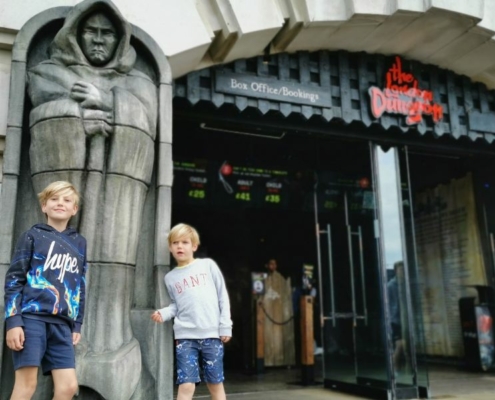


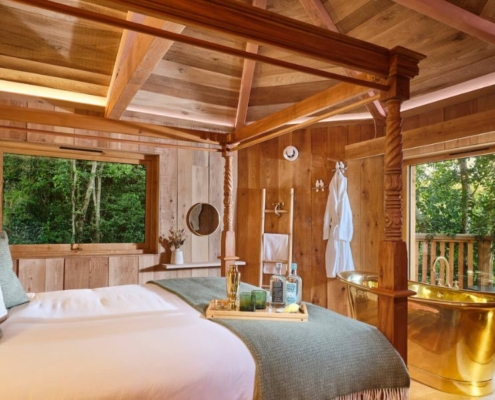


I ve been told that I had 2 great++++++ uncles that had a castle in England. They couldn t pay the taxes on it so it was lost. They went to U.S. I can t find this castle, can you tell me something about it?????? Thank you, Marsha
Wow, that’s interesting. I’m afraid I wouldn’t know where to start with that. Good luck finding it.